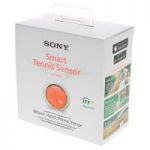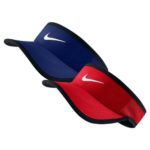The first word that comes to mind when people think of Sony is probably television. For 2015 that word is poised to change to tennis. Sony is diving head first into the world of connected tennis with their all new Smart Tennis Sensor. Debuting to the market later than Babolat’s Play models and the Zepp Tennis Sensor, Sony’s new connected device boast some impressive specs and features that make it a very worthy option for players interested in analyzing their game in greater detail. Having reviewed the previous connected tennis models to hit the market, I was excited to hit the court with the Sony and see how it measures up in this growing segment of training tools.
Connectivity & Usability
 The Smart Tennis Sensor uses Bluetooth to pair with your compatible Android or iOS device. It connected to my phone very quickly every time and the app’s home screen does a good job displaying whether the sensor is connected or not. There is both a power indicator light and a Bluetooth light to indicate on the sensor itself that it is powered on and connected. The first time you open the app after downloading it, you will create a profile and must login to Sony’s network with either an existing ID or by creating a new one. During play you can choose from displaying data live on your phone or have it store your swings in an offline memory mode. In memory mode the sensor can store up to 12,000 swings before the data will need to be downloaded to the app.
The Smart Tennis Sensor uses Bluetooth to pair with your compatible Android or iOS device. It connected to my phone very quickly every time and the app’s home screen does a good job displaying whether the sensor is connected or not. There is both a power indicator light and a Bluetooth light to indicate on the sensor itself that it is powered on and connected. The first time you open the app after downloading it, you will create a profile and must login to Sony’s network with either an existing ID or by creating a new one. During play you can choose from displaying data live on your phone or have it store your swings in an offline memory mode. In memory mode the sensor can store up to 12,000 swings before the data will need to be downloaded to the app.
 The sensor is charged using the included cradle and USB cable for charging either through your computer or a mobile device charger. The mounting system is where the Sony has a leg up on its closest competitors. You simply remove the trap door from your compatible Yonex, Wilson, Prince or Head frame and snap in the included adapter ring. The sensor then mounts to the adapter and locks into place with a solid “click.” Mounting is extremely solid and it is highly unlikely the sensor will be jarred loose. The low profile design of the sensor also keeps it from being obtrusive. I grip fairly low on the handle and noticed it contacting the palm of my hand a couple times but never in a bothersome way.
The sensor is charged using the included cradle and USB cable for charging either through your computer or a mobile device charger. The mounting system is where the Sony has a leg up on its closest competitors. You simply remove the trap door from your compatible Yonex, Wilson, Prince or Head frame and snap in the included adapter ring. The sensor then mounts to the adapter and locks into place with a solid “click.” Mounting is extremely solid and it is highly unlikely the sensor will be jarred loose. The low profile design of the sensor also keeps it from being obtrusive. I grip fairly low on the handle and noticed it contacting the palm of my hand a couple times but never in a bothersome way.
 Another benefit of the slim design and mounting system is the much lower overall weight that players are adding to the butt end of their racquet. The sensor and mount only add roughly 8 grams and while that may impact the balance point a bit, it is not nearly as noticeable as other options on the market. I found the weight a pretty easy trade off for being able to move the sensor around to different racquets rather than being locked into one specific model.
Another benefit of the slim design and mounting system is the much lower overall weight that players are adding to the butt end of their racquet. The sensor and mount only add roughly 8 grams and while that may impact the balance point a bit, it is not nearly as noticeable as other options on the market. I found the weight a pretty easy trade off for being able to move the sensor around to different racquets rather than being locked into one specific model.
Data Collection
Using cutting edge wave and motion detection built from Sony’s expertise in audio and video technology, the sensor analyzes your racquet speed, swing type, ball speed, spin level and impact location. One of the immediate benefits I noticed was that the Smart Tennis Sensor differentiates volleys from groundstrokes, which is a difference from early versions from its competitors. It also recognizes topspin forehand and backhands, serves and smashes. I was impressed with the sensor’s accuracy, both in differentiating shot types and its ability to map the impact location of each shot on the string bed.
When reviewing your hitting data, you are presented with an overview of your shots broken into a sort of pipe chart for how many of each shot were performed. From there you can drill down into the specifics for each shot type. Each shot shows a heat map of where on the string bed you were making contact. The heat map style visual is a cool way to gauge your overall timing and accuracy with each shot. You can also see the level of spin on the shot. Spin is displayed as a rating between -10 (maximum slice) and 10 (maximum topspin). Also displayed are your swing speed and ball speed (either km or mph). All three categories are displayed as a line graph of your shot history including overall average, maximum and minimum.
The Live Video Mode is one of the best features the Smart Tennis Sensor has to offer. During live data collection, you have the option to record the session and have the data synced to every shot recorded on video. You can then review the video and even have the app break the video apart by shot type. Each time a shot is about to be struck on the recording, the app displays all of the data collected for that shot. Find a shot you want to be able to replicate? You can utilize slow motion to break the shot down and a companion app called Motion Shot to create a frame by frame breakdown of any individual stroke. This feature is an incredibly powerful coaching tool for identify proper mechanics and being able to reinforce them. In future updates, I hope they would find a way to allow narration of the videos and/or be able to draw on them like a tele-strator for enhance coaching. Don’t expect to be able to video any marathon matches though. Sony lists only 90 minutes of battery time when in Live mode and about 180 minutes in offline memory mode. Players will definitely want to be sure the sensor is fully charged before they take the court each time.
Overall
 Sony’s first foray into the connected tennis market is an extremely impressive one. The Smart Tennis Sensor boasts a low profile build that is unobtrusive when installed and adds minimal weight to the player’s frame. It’s impressively accurate sensor and deep data collection make it capable of providing valuable insight. The Live Video Mode could prove to be a game changer, literally, as it allows players and coaches to make visual connections to mechanics they should emulate and the performance those shots produce. While the long term progression charting and social sharing features have some room to grow, the feature set is deep enough to satisfy players of any level. As with all of the other devices on the market, player should expect to see the capabilities and tools refined and expanded upon in future software updates from Sony. For $199, the Sony Smart Tennis Sensor offers a wealth of data, addictive video recording and the freedom to use multiple types of racquets as desired. Any player who wants the data to improve their game should visit Tennis Express and take a closer look before they hit the court.
Sony’s first foray into the connected tennis market is an extremely impressive one. The Smart Tennis Sensor boasts a low profile build that is unobtrusive when installed and adds minimal weight to the player’s frame. It’s impressively accurate sensor and deep data collection make it capable of providing valuable insight. The Live Video Mode could prove to be a game changer, literally, as it allows players and coaches to make visual connections to mechanics they should emulate and the performance those shots produce. While the long term progression charting and social sharing features have some room to grow, the feature set is deep enough to satisfy players of any level. As with all of the other devices on the market, player should expect to see the capabilities and tools refined and expanded upon in future software updates from Sony. For $199, the Sony Smart Tennis Sensor offers a wealth of data, addictive video recording and the freedom to use multiple types of racquets as desired. Any player who wants the data to improve their game should visit Tennis Express and take a closer look before they hit the court.
About the Reviewer: Matt Locke currently serves as the Junior Programs & Development Coordinator for USTA-Idaho and is an active USTA League and Tournament player.



